Signs That You Might Need Braces
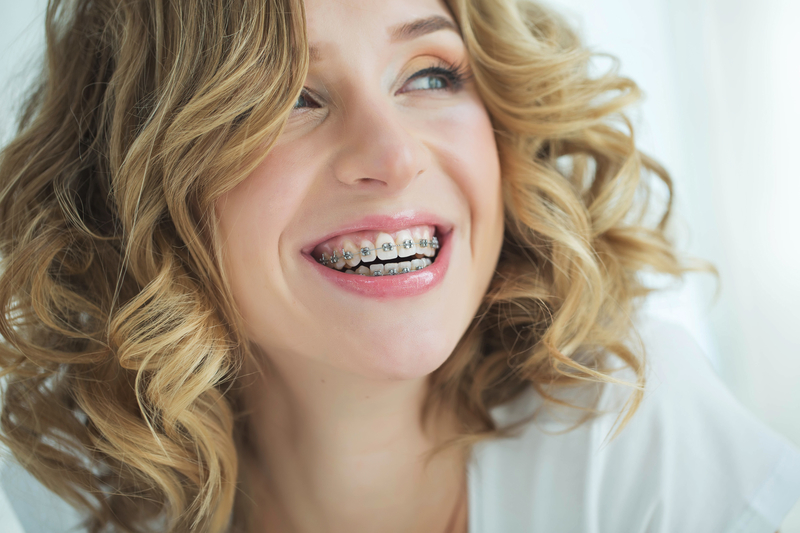
For many patients, getting braces is a big decision that affects oral health. How do you know whether you or your child needs braces, though? Some symptoms are obvious: misplaced or crowded teeth, or teeth that don’t meet normally. Other signs that you need braces are more inconspicuous, though, such as biting the cheek or a jaw that pops or shifts. While some of these symptoms are more serious than others, orthodontic care is the way to go to alleviate pain and correct any underlying issues. Learn about what signs you should be looking for to decide if braces are right for you with these tips!
What To Look Out For
As our teeth begin to erupt at a young age, they can fill into improper spaces or cause problems with adjacent teeth. Crooked or misaligned teeth aesthetically aren’t very pleasing for people, and most patients end up receiving orthodontic treatment during some point in their lives. Orthodontic problems don’t always mean crooked teeth, though. While there are some obvious signs that you might benefit from orthodontics, such as crowded teeth or an underbite/overbite, there are other symptoms that are less noticeable but equally as undesirable. The American Association of Orthodontics recommends that children have their first orthodontic visit between the ages of 7 and 8, but if certain complications are present, your child does not and should not wait until that age to be seen. If you have a young child, look for some of the following symptoms that warrant orthodontic care:
- Thumb or finger sucking
- Early, late or irregular loss of baby teeth
- Difficulty in chewing or biting
As children age, orthodontic problems will begin to show themselves, but some don’t appear until adulthood. No matter your age or prior orthodontic care, there are other symptoms that indicate a problem and should be addressed by an orthodontist. If you are struggling with a popping jaw, have to breathe through your mouth on a regular basis, are constantly biting your cheeks, and/or noticing teeth or jaws that are out of proportion to the rest of your face, you should have an orthodontic consultation. While many of these symptoms seem harmless or aren’t very noticeable, they can have long-term consequences that can negatively affect your oral health. Braces can remedy these issues so that your oral health isn’t compromised. It’s never too late for you to take charge of your oral health and get the smile that you deserve!
Advantages of Early Orthodontics
Not all kids will need orthodontic care, but many will. Meeting with your child’s dentist early on will help them determine whether your child would benefit from orthodontic treatment. If you have a child who needs an orthodontic issue remedied, there are certain advantages that come after receiving braces. Having your child evaluated by an orthodontist can help he/she observe the progress of incoming teeth, guide teeth into their ideal positions, monitor face and jaw development, detect hidden dental issues and reduce the risk of impacted teeth. For young children, orthodontic visits can sometimes be scary. Nonetheless, child orthodontic visits are simple and non-intrusive, so as to keep your child comfortable and happy. At Belmar Orthodontics, we do our best to give your child the care they need while making sure that their fears and questions are addressed. For adolescents, our options at include aesthetically-minded treatment options that will help your teen feel less self-conscious about braces. Braces can sometimes be seen as “dorky” or “uncool” for teens, but the list of options your teenager can choose from will give them plenty of choices to get straight teeth while still looking cool. Good oral health habits are started at a young age, and bringing your child in to see the orthodontist will help them establish those habits that will last a lifetime.
How You Can Benefit From Adult Orthodontics
Against popular belief, braces and orthodontic care aren’t just for kids and teenagers! In fact, one in five orthodontic patients is an adult; in just the U.S. and Canada alone, more than a million orthodontic patients are adults! You, as an adult, can benefit from the same care that young patients do and fix the orthodontic problems that you’ve been suffering from since childhood. As long as your teeth are healthy, you can receive orthodontic treatment at any age. The most common benefits of adult orthodontics include the following:
- More discreet treatment methods
- Correction of lifetime dental issues
- Faster treatment time than previous treatments
- Increased confidence and self-esteem
It’s important to note, however, that any previous orthodontic problems, such as periodontal disease or decayed/missing teeth, will need to be addressed before an orthodontic appliance can be placed. Once those issues are fixed, you’ll be fitted with braces and can continue your life just as usual. If you so choose, you can even opt in for hidden lingual braces or Invisalign clear, which will get you the straight teeth that you want while being completely unnoticeable. Speak with your orthodontist to determine which braces would be best for your needs before making any decisions.
Staying On Top Of Your Oral Health
Before any patient can receive orthodontic treatment, the health of their teeth, gums and mouth will first be evaluated. For this reason, it is important that children and adults alike are brushing twice a day and flossing on a nightly basis. The foods we eat also affects our oral health, as well. Especially during orthodontic treatment, certain foods, like sticky or sugary candies and food, can damage orthodontic appliances and make it easier for tooth decay to develop as plaque builds up on teeth. Brushing and flossing will partly diminish the effects of these foods, but not entirely. Make sure that you and your children are eating a healthy diet with minimal sugary snacks to avoid dental complications during treatment.
To ensure good oral health during and after orthodontic treatment, schedule an appointment with Belmar Orthodontics at (303) 225-9016 for a consultation.
How Upper Jaw Expansion Can Benefit Your Child
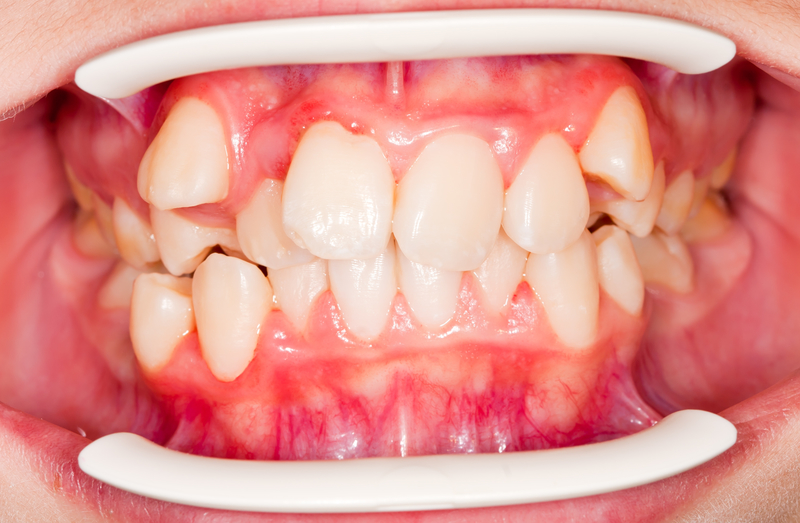
Upper jaw expansion is an orthodontic treatment that creates more space growth for developing kids by widening the circumference of the palate. This procedure helps correct crossbites, reduces overcrowding, and improves breathing ability. Most adolescents will receive this treatment before 16 years of age, but adults can also expand their upper jaw, if needed, as well. Read on to find out how upper jaw expansion works and what the advantages are with these tips!
Jaw Positioning and Malocclusion
Many patients deal with malocclusion, or crooked teeth and a poor bite. A poor bite refers to the way the upper and lower teeth line up, which is affected by the structure of the jaw. A “normal bite” consists of the upper teeth sitting slightly forward of the lower teeth, which allows for proper movement. Malocclusion is normally a cosmetic problem, but when it interferes with how teeth erupt, it can cause crooked teeth and tooth decay. A common cause of malocclusion is having too much or too little room in the jaw, which affects whether teeth grow in crowded or crooked. The shape and size of the jaw can also affect how severe someone’s malocclusion is, but thumb-sucking and tooth loss can also influence this process. For many patients, especially children, malocclusion is caused by a limited amount of space in the mouth for teeth to grow, so they either grow in crooked or the bite is altered. For this reason, many young dental patients receive upper jaw expansion treatments to allow more room in the mouth and prevent malocclusion. As more study and insight has been gained on the structure of the mouth, there are now more possibilities to fix incorrect bites, adjust occlusion and prevent crooked teeth starting from an earlier age.
Reasons For Upper Jaw Expansion
Upper jaw expansion is a specific treatment for widening the circumference of the palate to increase the perimeter of the dental arch in the mouth, which creates more space for teeth to grow. When there is enough room for teeth to grow, they are more likely to develop correctly. During childhood, palatal or maxillary expanders are used to aid this process. Through these expanders, dentists can help correct a crossbite that is caused by malocclusion. Normally, the upper teeth should close around the outside of the lower teeth, but when someone has a narrow palate, the opposite can occur and create a crossbite. As the upper teeth bite inside the lower teeth, an asymmetrical growth of the lower jaw can develop and change the symmetry of one’s face. This can cause serious complications if not addressed early on. Lastly, upper jaw expansion methods improve breathing ability, which is greatly affected by a narrow jaw. A narrow or deep upper jaw can make it difficult for a child to breathe through their nose and results in constant mouth breathing. While it doesn’t sound very serious, consistent mouth breathing keeps the mouth open at night, allowing for unfiltered bacteria to enter into the oral cavity, causing dry mouth and halitosis (bad breath).
Treatment Options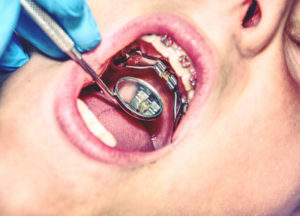
Upper jaw expansion is most successful when done at an earlier age while the mouth is still developing. For adults, those with a crossbite may only need a dental expansion instead of a palatal expansion, but may need surgery if palatal expansion is required to fix concerns. Depending on the age of the patient and the reason for treatment, a rapid palatal expander (RPE) may be used to increase the width of the jaw. The RPE is attached to the upper molars by bonding or cemented bands, and uses a special key that is used to widen the space by turning a screw in the appliance at certain points in time. This process puts extra pressure on the two halves of the upper jaw, which causes extra bone to grow between them. Gradually, by turning the screw with the key each day, the jaw widens to make room available for developing teeth. For adults, removable expanders can be used, as well, whenever the degree of expansion is minimal. Resembling a partial denture, removable expanders are typically made of chrome and recommended for adults as they more easily comply with treatment. After treatment, an orthodontic retainer may be given to maintain the space until all permanent teeth have developed. A third but least common option for expansion is a surgically assisted rapid palatal expander (SARPE), which is a combination of orthodontic treatment and surgery. This is used in the case that expansion cannot be achieved by the appliance alone. A custom appliance is made before surgery, and while during surgery, the upper jaw is intentionally fractured to separate it into movable sections. This allows the bone to grow between the fractures after the appliance is inserted.
Pros and Cons
Palatal expanders help straighten teeth, improve breathing and fix incorrect bites, but there are important suggestions to make note of. Since children are most likely to have one, a palatal expander, just like any orthodontic appliance, needs to be thoroughly cleaned each day to prevent plaque buildup and decay around the teeth. For young children, this can be difficult to do without help and can be easily overlooked, so parental supervision is essential. Additionally, the entire process can cost up to $3,000, depending on the degree of correction. For many, there is also some minor discomfort during expansion, but it is well worth it when you’re avoiding an inaccurate bite later in life.
For more information on which treatment option is best to fix yours or your child’s palate, call Belmar Orthodontics at (303) 225-9016! Our experienced team is dedicated to improving your oral health and getting you the smile that you deserve!
Is It Too Late For Me To Get Braces?

Most orthodontic patients receive their braces at a young age, typically during the teenage years. Are the teenage years the best time to receive braces, or will treatment work just as well as an adult? With the technological advances that have occurred, adult orthodontics have more options than ever to straighten smiles of all ages. Some benefits of adult orthodontics include correction of life-time dental issues, faster treatment time than former technology, and increased confidence. If you’re ready to change your smile, learn how adult orthodontics can help you through these tips!
Braces Throughout The Years
Modern advances in orthodontic treatment has revolutionized how quickly children and adults alike get the healthy and straight smiles they want, and allowed people of all ages to improve their oral health, no matter their age. For many years, traditional metal brackets were the only option to straighten teeth, but as technology has advanced, a variety of aesthetic bracket systems have been developed to give you the smile you want with braces that are less noticeable and easier to maintain. Permanent braces now come in two options: metal or ceramic. Ceramic braces are matched to teeth color, making them nearly invisible during treatment. Lingual braces are also an option, which are completely disguised from others as they are attached to the back of the teeth. Removable orthodontic appliances have recently come into play as a clear plastic aligner that is used and removed as needed. These aligners are advantageous to adults because they are less visible and easier to clean and maintain, which comes in handy for those adults busy with work and family life. As the options for braces have broadened throughout the years, so has the number of adult patients being treated for braces. Technological advances in the orthodontic industry now allows for more patients, even those who have passed the prime age for orthodontic care, to change their smiles during any part of life.
Benefits of Adult Orthodontics
The American Association of Orthodontists reports that of the 4.5 million Americans that are currently receiving orthodontic care, 25% of them are adults. Although childhood is the ideal time to receive braces, adult orthodontics has become a popular option for those who couldn’t receive treatment during adolescence. Some benefits of adult orthodontics include:
- More discreet treatment methods
- Correction of lifetime dental issues
- Faster treatment time
- Increased self-esteem and confidence
Adults ultimately have more options when choosing what braces and treatment plan is best for them. Orthodontic care protects both kids and adults against tooth decay, tooth loss, gum disease, impaired speech, chewing and jaw problems. While cost is a factor, you will still need an oral evaluation and orthodontics consultation to determine your candidacy for certain procedures and treatments. For the first time, adults of any age who have otherwise healthy teeth can benefit from orthodontic treatment at any point in life.
What To Expect With Adult Orthodontics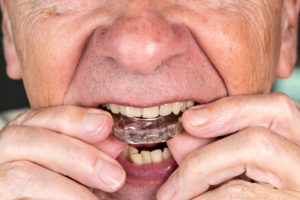
Typically, it is more difficult to manipulate an adult’s fully-developed jawbone compared to the pliable jawbone of a child, but modern-day advances now allow orthodontists to correct crooked teeth with great success and precision. Any oral health issues, such as periodontal (gum) disease, will have to be resolved before teeth can be straightened, so meeting with your dentist and orthodontist will be an important first step to take before treatment can begin. If you’re considering orthodontic treatment to correct any cosmetic or bite issues, consider the following:
- The entire process may take longer for an adult than a child. Typical treatment time averages two years, but varies from person to person.
- Fully-developed bones in adults have stopped growing, so some structural changes cannot be achieved without surgery.
- Adults may need to see a periodontist, as well as a dentist and orthodontist, to ensure that treatment will not be complicated by bone loss due to gum disease.
Adults who have had teeth removed in the past might have difficulties with orthodontic care as old extraction sites might not be suitable for teeth to move into. Adult patients receiving treatment also have a higher risk for root absorption than children do as their bodies reabsorb the root of the tooth, leaving no room for anchorage. This process causes teeth to loosen and fall out over time due to gum instability. Since braces and other appliances are cemented directly to the teeth themselves, it is important that all patients, even adults, maintain good oral health practices that will prevent the areas around the brackets from developing plaque and tooth decay, which will ensure that they get the best (and healthiest) smile possible.
Schedule An Appointment Today
If you are interested in adult orthodontics or are wanting to improve the look of your smile, call Belmar Orthodontics at (303) 225-9016 for a consultation to learn about which options are available for you. Our dedicated team of professionals are determined to help you get the smile that you want and improve your oral health!
Why You Need Both a Dentist and Orthodontist
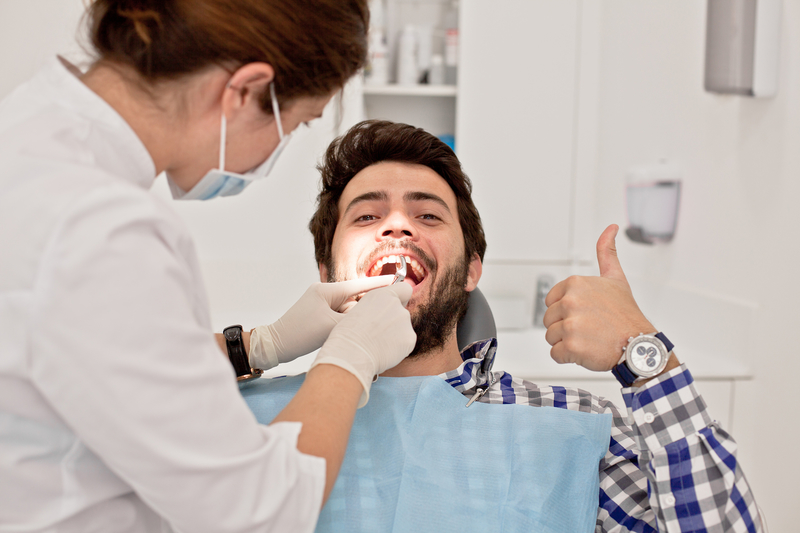
Dentists and orthodontists are both highly-trained professionals that can transform your smile. However, they provide completely different services to patients and both may be needed to help get your smile as healthy as possible. Orthodontic treatment connects to dentistry in many ways, as do the professionals themselves. If you’re like many others, you may need both professionals to keep your oral health in check.
Your Oral Care
Did you know that your oral health can affect all other aspects of your health? This is especially true if you already have some chronic conditions such as diabetes and heart disease. If your oral health isn’t taken care of, your overall health can worse and you are more susceptible to infection. If you don’t control chronic conditions, your oral health can worsen, as the blood vessels that nourish your teeth and gums can become damaged. Your teeth are more likely to decay and get infections that lead to tooth loss.
That is why taking care of your oral health is so important. It can help determine the state of your overall health and if you keep your teeth for a few years or for many. Many people need both an orthodontist and a dentist to help keep their mouth healthy. Not everyone needs an orthodontist alongside their dental care, but millions do. At least 4 million are getting braces each year in the United States alone to correct bite, alignment and problems with the teeth that lead to oral health diseases. When oral health care is happening at home, yet gum disease tooth decay continue to happen, it’s time to also seek help from an orthodontist.
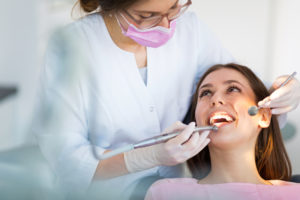
How Can a Dentist Help You?
A dentist is a professional that every person needs. Dentists are vital to you having good oral health for life. They can detect the presence of tooth decay, gum disease, oral cancer, oral sores and any other oral problem, plus they do the work to help correct those issues. These professionals go to school for 10 years just learning about your mouth and facial structures so they can help you stay healthy. Orthodontists receive all that same training, plus 2-3 extra years learning about straightening teeth, bite and alignment issues and structural problems with the mouth.
Because these professionals do different work, you will probably need both. Dentists have the primary duty to find the presence of tooth decay (cavities) using digital and x-ray technology. Then they have many different procedures to remove decay, fill the cavity, and restore your smile. They can do cosmetic work to make your smile look better and they deal primarily with oral health diseases and helping you avoid them so you don’t have early tooth loss. Orthodontists are trained to see cavities and oral health issues, but they will do structural work to help change your smile instead of dealing with the disease aspect of your oral health. Their work focuses on prevention of those issues in the first place.
How Can an Orthodontist Help You?
Did you know that people have had orthodontic care at least since the time of the Ancient Egyptians? More discoveries are finding orthodontic appliances on teeth thousands of years ago. Why? Because people that long ago also understood the benefits of straighter teeth. It took many centuries for orthodontists and orthodontic work to become established.
Studies found that straighter teeth made dental issues less likely to happen. When patients received orthodontic straightening—even through crude methods—they were less likely to have their teeth decay or break and less likely to have gum issues. The same holds true today. Crooked teeth are teeth that are much harder to clean. In a straight, even bite, the top front teeth rest just slightly in front of the bottom front teeth. From the front to the back, the teeth rest evenly on one another, evening out pressure from biting, chewing, eating, talking and more.
When the teeth are crooked, patients will get areas where they simply can’t get a toothbrush or floss to and those areas decay. The teeth may be at odd angles, and with uneven pressure placed on those teeth all the time, they may simply break. If you have crooked teeth, an orthodontist can easily make a plan to straighten them. Using digital x-rays, an orthodontist can examine your bite, alignment and incoming teeth and can make a plan to ensure all your teeth line up for the best oral health you could have.
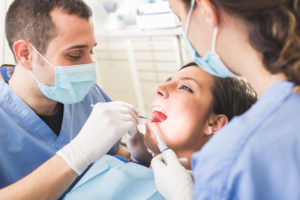
Do You Need an Orthodontist?
Not everyone will need an orthodontist, but their care can benefit most people. Even getting slight straightening of the teeth can reduce your dental breaks, emergencies and issues with oral health diseases. Orthodontic care can even help with bad breath if that stems from plaque and bacteria in the mouth that you can’t quite get rid of. To know for sure if you need an orthodontist, make sure to schedule an examination.
For children, the national recommendation by groups such as the American Association of Orthodontics is to visit an orthodontist around age 7 or 8. This is a key time for an orthodontist to be able to tell if the incoming adult teeth are coming in at the correct angle and place in the mouth. Oral health issues that can become severe later on in life can be caught early and childhood and many oral problems can be prevented with some orthodontic care. For all other issues with finding and filling cavities, gum disease, sores and more, make sure to call your dentist. To schedule your consultation with the orthodontist, call Belmar Orthodontics today at (303) 225-9016!
Dressing Up Your Smile During the Holidays

The holidays are here, which means parties, dinners, photo opportunities and more. Now is a great time to make your smile shine, and you can do that through orthodontic treatment. If you’re smile is lack-luster, consider our four orthodontic options that can help you have a straighter smile. For those already with braces, you can dress up your brackets with bright colors to reflect the season. Use these tips for getting a more beautiful smile with braces and having that show in your holiday snapshots this year!
Dress Up Your Smile with Orthodontics
The higher number of holidays during the winter season is believed to be because of the many pagan festivals that surrounded the Winter Solstice many years ago. That solstice happens in the third week of december, where there is Christmas, Hanukkah, New Years and other holidays all happening. With all those holidays and the gatherings that come with them, it’s likely to mean many opportunities for photos and showing off your smile. You want that smile to impress.
Studies show that people that straighten their smiles often feel more confident than those who don’t. That confidence can be visible even while you are currently getting orthodontic treatment. Straight teeth are so important to people that 87% of people are willing to forego something they want for a year or more to be able to get braces. If you have braces, not only is it something to be proud of, but something to be admired. If you don’t have braces, getting them is a great way to give yourself an amazing gift just in time for the holidays.

Your Treatment Options
In the past, metal braces were your only option. However, you have many cool options today that you can gift yourself such as:
- Traditional Metal Braces – These are the classic metal bracket and wire option that is most commonly chosen by patients. Patients who chose this option come in to have their wires tightened at each appointment.
- Ceramic Braces – These braces are a close cousin to metal braces. They have the same bracket and wire design of metal braces, except that they are made out of ceramic material. This helps decrease demineralization during your orthodontic treatment. Ceramic material is also naturally white, helping these braces to blend in with your teeth more than metal would.
- Lingual Braces – These are metal braces that are placed on the back of your teeth. Instead of just a square bracket, the metal must be custom-made to the shape of the back of your teeth. This is a discrete option that adults and teens love.
- Invisalign Treatment – This is the most invisible option available to our patients. Invisalign is a series of transparent aligners that you wear at night and throughout the day. You can remove them for eating, playing sports, cleaning your teeth and more.
If You Already Have Braces
Maybe you already have braces. You can still make your smile wow in pictures by taking care of your smile. If you have metal or ceramic braces, our patients love to get colored bands that reflect the colors of the holidays. You can make your bands green and red for Christmas, blue and white for winter or any color you would like. Colorful bracket bands are just one way you can dress up your smile.
If you already have braces, then you have already started on your journey to a better smile. Orthodontic treatment can correct mild to severe issues with bite and alignment, and can help correct speech impediments. It can bring the teeth and jaws into proper position, reducing your risk for oral health diseases such as tooth decay and gum disease. Straighter teeth are teeth that are easier to clean and less likely to have breaks and fractures from uneven mouth pressure.
However, if you want your smile to dazzle in photos and at holiday get-togethers, you have to take care of it. The best way to do that is by brushing and flossing your teeth. Those two simple steps should be dones several times a day to keep your brackets clean and your teeth polished. Patients should brush 3 times a day or more to dislodge food and to clean the teeth after meals. Flossing should be done 1-2 times a day. Even though it takes a bit longer to do, don’t skip this step! If you do, you miss cleaning 40% of your tooth surfaces that can leave them open to decay, erosion and staining. Those are not things you want in a holiday photo.

Better Health for the New Year
The end of the year is a time to start making goals for the new year. One of those goals can be focused around having better health in the new year. Many people don’t realize just how connected oral health is with overall health. Countless chronic conditions can become more mild or they can intensify depending on how well you are taking care of your oral health. For example, if you have diabetes, not taking care of your teeth and gums can lead to oral infections that are really hard to battle because you have diabetes. Your body is less able to fight those infections and the infections can spread, worsening your condition.
However, if you do the basics of brushing your teeth, flossing and visiting your dentist and orthodontist like you should, you can keep your oral health in great shape. That makes it so your smile is amazing when your braces come off instead of damaged or decayed. To get some tips for taking care of your braces or for starting on an orthodontic plan, call Belmar Orthodontics today at (303) 225-9016!
Braces Can Change Your Life
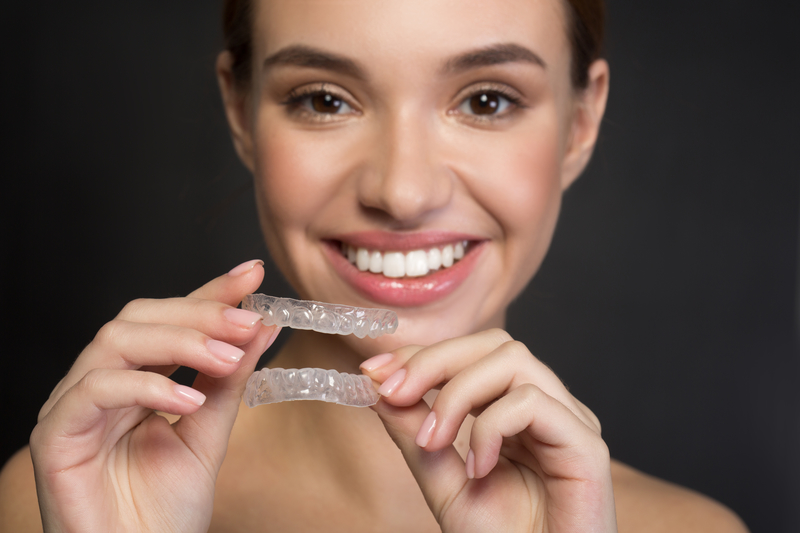
Your oral health can determine much of your overall health. Food and substances enter through your mouth, affecting your waistline, your appearance and your health. Your oral health can improve your overall health when you make changes in oral hygiene and bite and alignment. Misalignments in bites and crooked teeth can cause health and social problems, as they can lead to speech impediments, oral health diseases, and worsening chronic conditions. With braces, you can not only change how healthy your mouth is, but can change your life too!
Growing In Straight Teeth
Many people picture teens when they think of braces. However, 1/4th of people with braces are kids. Child orthodontics help straighten out teeth that would cause them speech problems, broken teeth and trouble growing in the permanent teeth. Adults and teens usually get them for crooked teeth.
However, braces aren’t just for people with crooked teeth. You may see patients young and old that appear to have a straight smile and yet they have to get braces. In this case, there is probably an oral health issue with the bite or alignment. Your teeth should line up along both the upper jaw and the lower jaw. When you go to the dentist, they will ask you to bite together so that they can view how your bite rests. How your teeth sit when they are resting together can determine if you will have dental issues and even speech impediments. This is especially true for young kids who are losing baby teeth and having adult teeth grow in.
Children have their baby teeth for years—even up to age 12 or later at times. Those baby teeth start to space out a bit more as a child grows from an infant to a school-aged child. Their mouth grows with them, making room for adult teeth. 20 baby teeth will become 32 adult teeth (including the wisdom teeth). However, those teeth don’t always come into the mouth in the right position or the right direction. With a healthy bite, the upper and lower jaws should have the teeth lining up evenly with one another. The teeth should be straight up and down, and the front upper teeth will rest just slightly in front of the bottom front teeth.
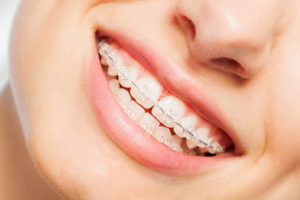
Braces Can Prevent Dental Injuries
When teeth aren’t straight and they jut out at different angles, it can mean broken, cracked or chipped teeth in the future. Those dental injuries would be caused by uneven pressure on certain teeth which will eventually break them or will cause areas of decay that you can’t clean well. The alignment of the teeth can also cause speech impediments when forming words, and those impediments can last for life if bite, alignment and crooked teeth aren’t corrected. For young children and adults alike, receiving braces for these issues can certainly change not only their oral health, but their life.
Braces are sometimes needed to make space in a patient’s mouth. Not all mouths grow to fit the incoming teeth, but that doesn’t mean the adult teeth won’t stop coming in. All your teeth will come in, even if they have to crowd out other teeth. That crowding can be painful and even one tooth coming in where there isn’t room can cause all of your teeth to go crooked. As a tooth comes in, it will slowly push other teeth from the area, which then have to shift. This is what wisdom teeth commonly do, and it can be painful as it messes up a smile. Braces can stop that from happening by making plenty of space in the mouth for teeth that are still coming in.
What If You Have Your Teeth Already?
The dental issues we have mentioned will generally happen before a person has reached adulthood. The American Association of Orthodontics recommends that children have their first orthodontic appointment around age 7 or 8. This is when we can see how the baby teeth are falling out and how the permanent teeth are coming in. We stop dental issues before they start forming, and during this time when the jaw bones are still soft enough to mold. However, at least 1/4th of patients that have braces get them when they are adults. The jaws have grow completely and have hardened into place by adulthood, making orthodontic treatment harder.
However, we said “harder”, not “impossible”. Orthodontic advancements can definitely help an adult change their smile to change their life. Now, more than ever, it is becoming increasingly important to have a straight smile as an adult. Studies show that others make an opinion of you based off of the first few seconds of meeting you. Your appearance can go a long way. Your smile is also one of the top 3 features others will notice first when formulating an opinion about you. Studies show that those with straighter teeth are seen as more attractive, successful, smart, healthy and trustworthy. Employers are more likely to hire those with straight smiles over those who don’t have them.

Your Options
If you’re an adult, you can straighten your smile without it being noticeable. Children often go the route of traditional metal braces or ceramic braces, which are the same but made from ceramic material. Adults and many teens opt for hidden options like lingual braces or Invisalign treatment. Lingual braces are metal braces that attach behind the teeth, staying hidden as they correct bite, alignment and your teeth. Invisalign treatment consists of transparent aligners patients change out every week. However, they don’t do as well with larger bite and alignment issues. It’s never too late to receive orthodontic treatment.
Whether you are young or old, you can change your smile to reduce or eliminate your problems with speech, tooth decay, oral health issues, dental injuries and to even feel more attractive. Want to see just how much braces can change your life? Call Belmar Orthodontics today at (303) 225-9016 to receive your free consultation!
Orthodontic Treatment as Restorative Dentistry

Did you know that getting your teeth straightened can be a form of restorative dentistry? This is because restorative dentistry seeks to restore or bring your smile to a more perfect state. Crooked teeth can become straight, which in turn starts to relieve the burdens of tooth decay, gum disease, bad breath and other oral health problems. If you want to restore your smile once more, see what our 4 different orthodontic options can do for you!
Why Is Your Smile Important?
Some patients don’t realize just how important a smile really is. Studies show that your smile is one of the first things another person will notice about you. Is that smile showing that you are healthy and confident? Or do you hide your smile because of crooked teeth, discoloration or other aspects you don’t like? When a smile looks good, studies show that people often feel more confident and they exude that confidence much easier. A better smile can lead a person to be more social and confident to pursue successful endeavors.
It’s not only what a smile does for a person themself that’s important. How your smile looks to others also will determine a lot about how successful you are. The makes of the orthodontic appliance Invisalign conducted a study about smiles, and what they found was quite amazing:
- 1/3rd of people notice a person’s smile before any other feature.
- Those who have a straighter, more beautiful smile are 45% more likely to get a job over a competitor with a crooked or discolored smile.
- Your smile can send messages about how healthy you are and how happy you seem. When that smile is straighter and more beautiful, others will see you as 21% more likely to be healthier and 47% happier.
- 73% of people are more likely to trust you at first glance if you have a better smile.
- You’re 58% more likely to be perceived as wealthy and 57% more likely to get a date if you have a great smile.

What Is Restorative Dentistry?
Your teeth will determine most of how good your oral health. When you eat, sugars in the food you eat mix with mouth bacteria. That creates plaque, or that sticky, acidic substance that coats your teeth. Over time, if proper oral hygiene habits aren’t observed, the teeth will change colors and decay. This happens much easier to the teeth if they are crooked. That’s because it’s harder to clean between the teeth if there is no way to get floss through crooked teeth.
Restorative dentistry seeks to restore smiles that are crooked or damaged through decay or gum disease (a disease to the gums that happens just like tooth decay). This form of dentistry consists of dental services such as teeth whitening, same-day crowns, root canal therapy and tooth-colored fillings. There are many dental patients that will get dental veneers—also known as “porcelain veneers”—to restore their smile. This is a dental service where the top layer of your teeth is taken off and replaced with a perfect, white tooth shell. However, once that part of your natural tooth is taken off, you can’t get that natural part back. Porcelain veneers do make your smile look beautiful, but they don’t change your crooked teeth or oral health issues underneath.
Fixing the Problem with Orthodontic Treatment
Fixing the problem permanently is a great solution to getting a beautiful smile and reducing your problems with tooth decay, gum disease, bad breath and more. Straighter smiles are ones that are easier to clean and ones that look attractive and healthy. Plus, once you straighten your smile with orthodontic treatment, it can stay that way for life. Orthodontics is different than dentistry, but is absolutely important to your oral health.
Dentists will fix problems with tooth decay and gum disease. Orthodontic treatment and restorative dentistry through those braces can help prevent problems in the first place. Plus, orthodontic braces are able to correct bite and alignment issues that are caused by misaligned bites and jaws. Those issues can cause speech and development problems without intervention. Without orthodontic treatment, other restorative dentistry methods can only do so much.
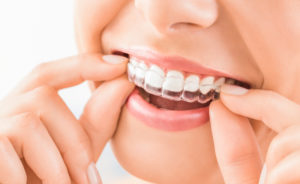
Restorative Dentistry for You
Our easiest method of restorative dentistry for teens and adults is through Invisalign treatment. This option works just as well as our lingual braces, ceramic braces and traditional metal braces. However, with Invisalign, the focus is on aesthetics as well as straightening. We want you to have a beautiful smile as you straighten, and Invisalign is a great way to achieve that.
Invisalign is a orthodontic treatment that is designed to be virtually unnoticeable on your teeth. Patients have their teeth digitally scanned in-office and a treatment plan is made for them, mapping out how orthodontic treatment will transform their smile in 18 months or less. Often, patients can straighten their smile in 1/3rd of that time, depending on the condition of the teeth, bite and alignment. Less office visits are typically needed for this type of restorative dentistry.
You simply wear your aligners for 20-22 hours each day (and overnight), and by switching out the aligners each week, your teeth shift into a straight smile over time. The benefit of this restorative dentistry option is that you are actually fixing the root cause of oral health problems. Crooked teeth cause tooth decay and gum disease to worsen, but you avoid that with a straight smile. With other restorative dentistry options (such as teeth whitening or veneers), you will still have the crooked teeth (although masked), and possibly the dental problems. Avoid all that while still getting a beautiful smile with Invisalign. If you want to learn more about this restorative dentistry option for adults and teens, contact Belmar Orthodontics today at (303) 225-9016!
How Bite Correction Can Change Your Life?
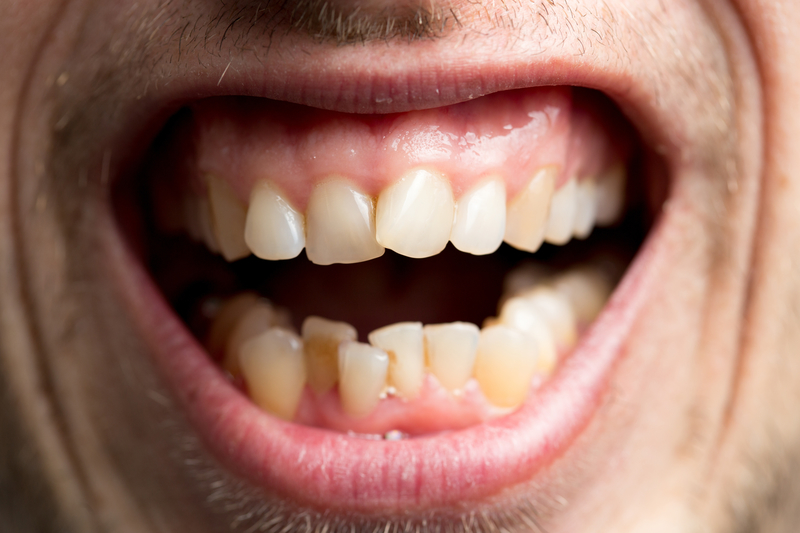
Do you or your child have a problem with their bite or alignment? These problems can seem small at first. However, as a child grows into an adult, bite or alignment issues could cause many health problems. It can even cause speech impediments and difficulty chewing in the future. Find out how bite correction can improve your health and just how important it is to get bite correction via braces if you need it!
Your Bite Should Be a Certain Way
The structure of your mouth is defined by how your teeth and jaws are formed. Your upper jaw and your lower jaw should both follow the same arch in a U shape. Those arches should also line up together. The teeth as well, should lie on top of one another evenly, with your back top molars resting on your back bottom molars all the way towards the front. In a normal bite, the front top teeth will rest on top of your bottom teeth, except they will be just slightly in front of those bottom teeth.
Orthodontic care is not just for teens that are looking to get a straighter smile. In fact, about 1/4th of all people that wear braces are actually children! The American Association of Orthodontics recommends that children have their first orthodontic visit between the ages of 7 and 8. Having an examination early-on helps prevent the progression of orthodontic issues, such as a misaligned bite. How a child’s mouth is forming is a great indication of what their mouth will look like as an adult. If we can already see that their teeth are growing at the wrong angles, or that their jaws don’t line up, we can predict that oral health issues will be present in the future. That is why having this orthodontic appointment at 7 or 8 is so important.
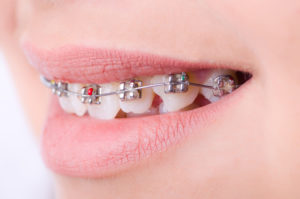
Types of Bites
When a child comes in to have their mouth examined, we can see how the top and bottom jaws line up. In a mouth with correct bite formation, the jaws will line up. If they do and the teeth are not coming in at crooked angles, then a child won’t need orthodontic care unless they want to straighten their teeth later on in life. However, prompt treatment will be needed for alignment and bite correction if a child or older patient has:
- Overbite – The upper front teeth overlap too much over the bottom front teeth.
- Underbite – The upper front teeth rest behind the bottom front teeth.
- Crossbite – Teeth are at varying angles in the mouth, which can lead to decay, broken teeth and speech problems.
Benefits of Bite Correction for Children
The ideal time to receive any treatment for bite correction is during the childhood years. This is when the mouth and jaws are still growing. Because the bones aren’t set yet, it is much easier for an orthodontic appliance to mold a bite into the correct shape without too much effort. This is generally why a child would receive bite correction treatment before they are 10 years old.
If a child receives bite correction via braces, they benefit from their mouth forming correctly. Where there were once speech problems developing, their speech can start to sound normal without lisps or other impediments. Facial features will appear more normal because the structure of the mouth will be maintained with orthodontic appliances. In a child with severe bite problems, some people can physically see parts of the jaws jutting outward. This makes the face look different than it should, and speech will almost certainly be compromised. We stop that incorrect shaping before the jaws harden later on and before dental diseases and problems are developed.
Even if you don’t detect any dental issues with yourself or a child, there are still many advantages for bite correction and braces at an early age such as:
- Observing the progress of incoming teeth
- Monitoring facial and jaw development
- Guiding incoming teeth into their ideal position
- Detecting hidden dental issues
- Reducing the risk of impacted teeth
- Decreasing the risk for permanent tooth extractions (as teeth won’t get uneven pressure that breaks them)
- Reducing the risk of cavities and gum issues that happen when the teeth are crooked and harder to clean
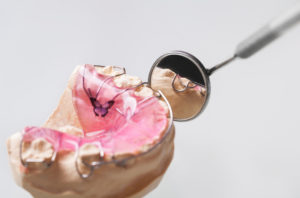
Benefits of Bite Correction for Adults
If you didn’t receive orthodontic care as a child, it is not too late to receive it later on in life. Adults and teens make up the other 3/4ths of patients that get braces. At about age 11 or 12, most of the permanent teeth should be in the mouth. At this time, we can look at a patient’s teeth and see if they need their teeth straightened. When bite problems are present (because child orthodontics was not done), it is harder to do them as teens and adults, but it can be done with normal orthodontic appliances. In some cases, some surgery may be done to reshape areas of the mouth that have hardened into place.
However, the benefits of bite correction and tooth alignment for teens and adults is astounding. Studies show that people perceive you as more successful, healthy and happy if you have straighter teeth than if you have crooked teeth. You’re more likely to get a job over someone that has crooked teeth, because your smile is an expression of your health and how well you care for yourself. That can translate into how well you care for other things, like your obligations.
Studies show that in adults and children alike, that confidence soars and smiles are shared more often when people feel good about their smiles. That confidence boost can change your entire outlook on life, and can lead you to be a more successful person than you otherwise could be. If you have teeth in need of bite correction or straightening, don’t hesitate to see what orthodontic care can do for you! Call Belmar Orthodontics today at (303) 225-9016!
Tips for Success with Early Orthodontics
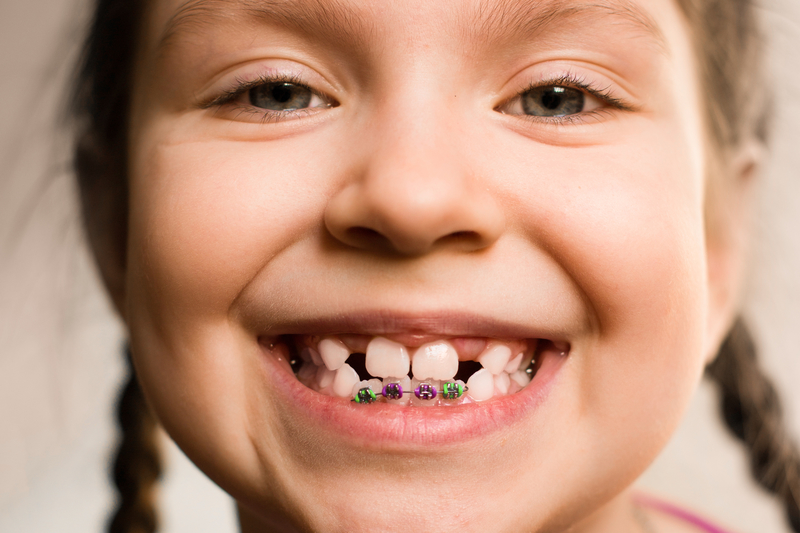
You need to help your child learn how to properly take of their teeth through brushing and flossing. However, having clean teeth isn’t everything. Early orthodontics is needed for some children who have bite and alignment problems that could lead to problems later on in life. Early orthodontics seeks to correct bites to avoid problems with speech, biting, chewing, and more. If done correctly, early orthodontics can set a child on the path to a healthy mouth free of tooth decay and gum disease. Read on for our tips for success with early orthodontics and for protecting the health of small mouths!
Caring for the Baby Teeth
Your child’s teeth are delicate. Help keep them healthy and strong with the following tips:
- Rinse with water before brushing. Teach your child to rinse with water after eating. This will loosen food that may be caught in the braces. Follow rinsing with a thorough brushing. Teach your child how to properly brush their teeth and monitor them after they are able to use a toothbrush on their own. You will have to brush your child’s teeth until around age 3, or until they have the dexterity to brush and floss alone. Make sure they brush long enough, correctly, and several times a day. Brush an infant’s teeth with an infant toothbrush and increase the toothbrush size as they age. Children will need about a pea-size amount of toothpaste and infants will only need toothpaste equal to the size of a grain of rice.
- Floss once a day. Ensure your child is flossing each day or each night. Flossing helps loosen food debris and plaque at and under the gum line that can harden into tartar. Flossing also helps remove food debris from the small, hard-to-reach areas of the teeth that might be difficult to reach with a toothbrush. Flossing takes time to learn, so practice this skill frequently with your child.
- Use a fluoride rinse. Parents should always be the one to administer a fluoride rinse. Rinse with fluoride after brushing and before bed to help keep teeth strong and healthy. This treatment will help prevent tooth decay in your little one.
- Schedule dental visits every 6 months. After your child starts getting teeth, they should visit the dentist for a checkup and cleaning every 6 months. This will help keep your child’s mouth healthy during treatment.
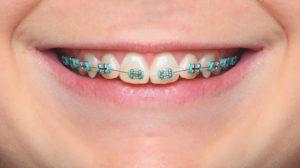
Early Orthodontics
The American Association of Orthodontics recommends that children have their first orthodontic visit between the ages of 7 and 8. Having an examination early-on will prevent the progression of orthodontic issues that can become severe later on in life. Not having your child’s bite checked can lead to problems with their teeth coming in correctly or staying upright. Teeth may form gaps between one another, making speech impediments common and making it more difficult to bite and chew food. Crooked teeth coupled with a misaligned bite also leads to chipped, broken or cracked teeth, as well as a higher risk for tooth decay and gum disease.
With early orthodontics, you are making an investment in your child’s future that will set them up for success the rest of their life. Early orthodontics is different than simply receiving braces as an adult or teenager. We adhere braces to your child’s teeth and then during their treatment we can:
- Observe the progress of incoming teeth
- Monitor facial and jaw development
- Guide incoming teeth into their ideal position
- Detect hidden dental issues
- Reduce the risk of impacted teeth
- Decrease the risk for permanent tooth extractions

Caring for Braces
At each appointment, we will adjust the wires so that a child’s bite will eventually line up correctly. These braces need to be cared for just as much as an adult’s or teenager’s braces. Cleaning the teeth with braces is much trickier, especially for young children, so their success is dependent upon how much parents help them care for their braces.
We suggest the following for having success with your child’s braces:
- Brush after every meal. If food doesn’t have time to sit on the teeth long, then you can prevent stained teeth and reduce the risk for bacteria buildup. This keeps your child healthier.
- Use threadable floss or a floss threader. Don’t let your child skip on their flossing or they could wind up with tooth decay when those braces come off.
- Use a proxabrush or waterpik. A proxabrush is a “Christmas tree brush” that you place between two brackets and below the archwire. Brushing back and forth can give the teeth a better clean. For hard-to-reach places in the mouth, children can also use a waterpik. This is a device that shoots water to dislodge stuck food. Children get a better clean when these two tools are used.
- Avoid hard or sticky foods. These types of foods lead to tooth decay or broken brackets. Avoid hard or chewy candies, chips, ice, apples, popcorn, nuts, corn on the cob, caramel and more.
Does Your Child Need Early Orthodontics?
If you haven’t gone to visit an orthodontist, schedule an appointment today! You can also ask your dentist if they see problems forming with your child’s bite and alignment. However, only an orthodontist can perform child orthodontics. Investing your time in correcting your child’s bite can set them up for success for the rest of their life. To schedule your child’s appointment for early orthodontics, call Belmar Orthodontics today at (303) 225-9016!

